The Amateur Mycologist - Random Find - Best Guess Is A Hemitrichia or Trichia Species Based On Rudimentary Microscopy
steemstem·@dber·
0.000 HBDThe Amateur Mycologist - Random Find - Best Guess Is A Hemitrichia or Trichia Species Based On Rudimentary Microscopy
## These posts are not for foraging. They are intended for entertainment and intellectual satisfaction only. These posts are not a field guide nor comprehensive in any way - their accuracy is not assured in any way. Do not eat wild mushrooms unless you are a professional, have substantial professional assistance or have a wealth of personal experience with a specific species. Do not make any foraging decisions based on these posts. To do so could be dangerous or life threatening.
## This post does not include edibility or toxicity information
********
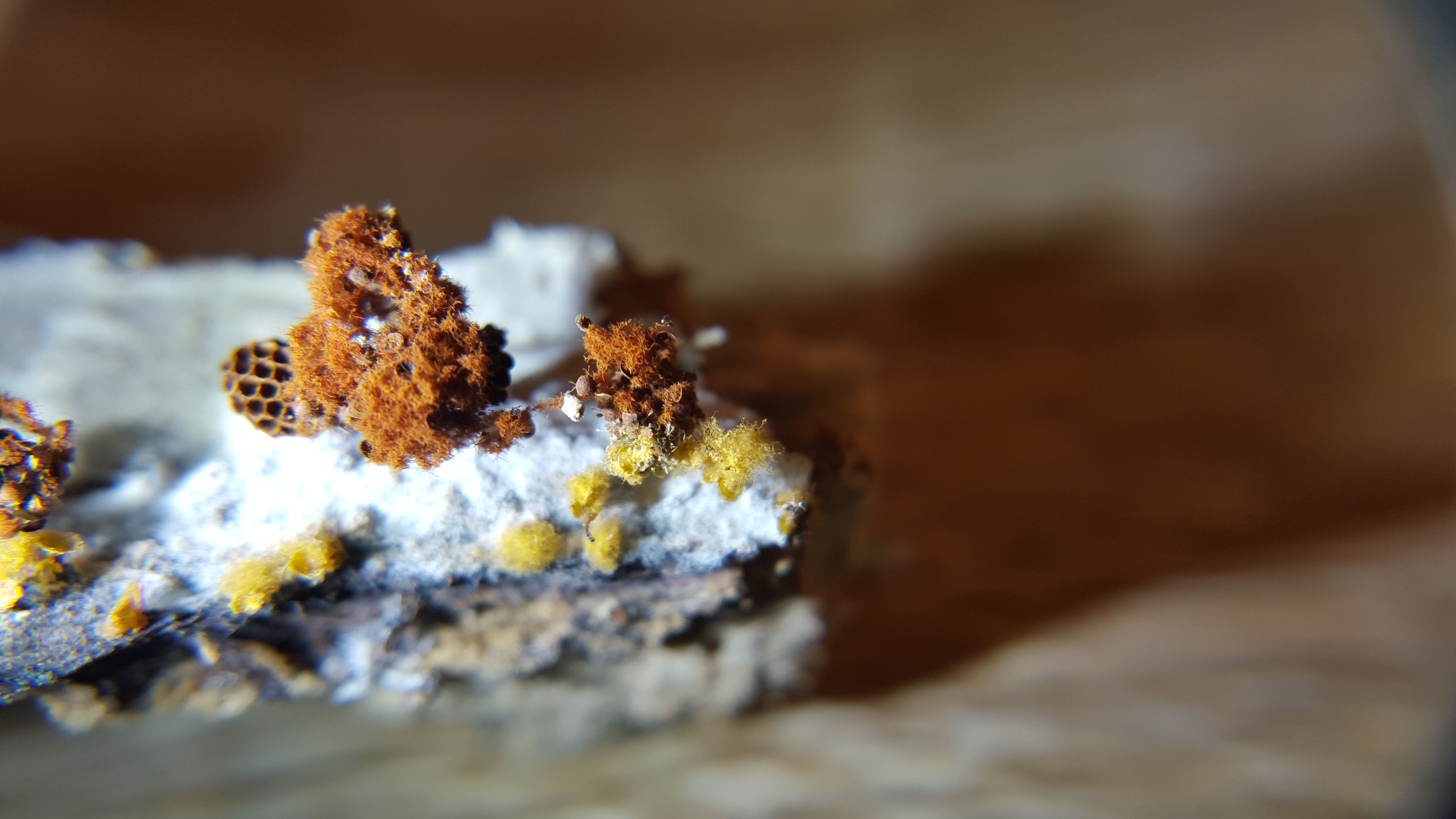
## Last time we considered the red portion of this picture - now we move on to a far more difficult puzzle piece
What is that yellow stuff? No doubt at all that it is the final part of a slime mold's life cycle, but in terms of *what* slime mold, I have more questions than I do answers. **Spoiler alert - we are not going to get very far in ID'ing these yellow guys, in part because of microscopy issues that the new camera may rectify.**
#### But first let's take a closer look at that photo.
**********
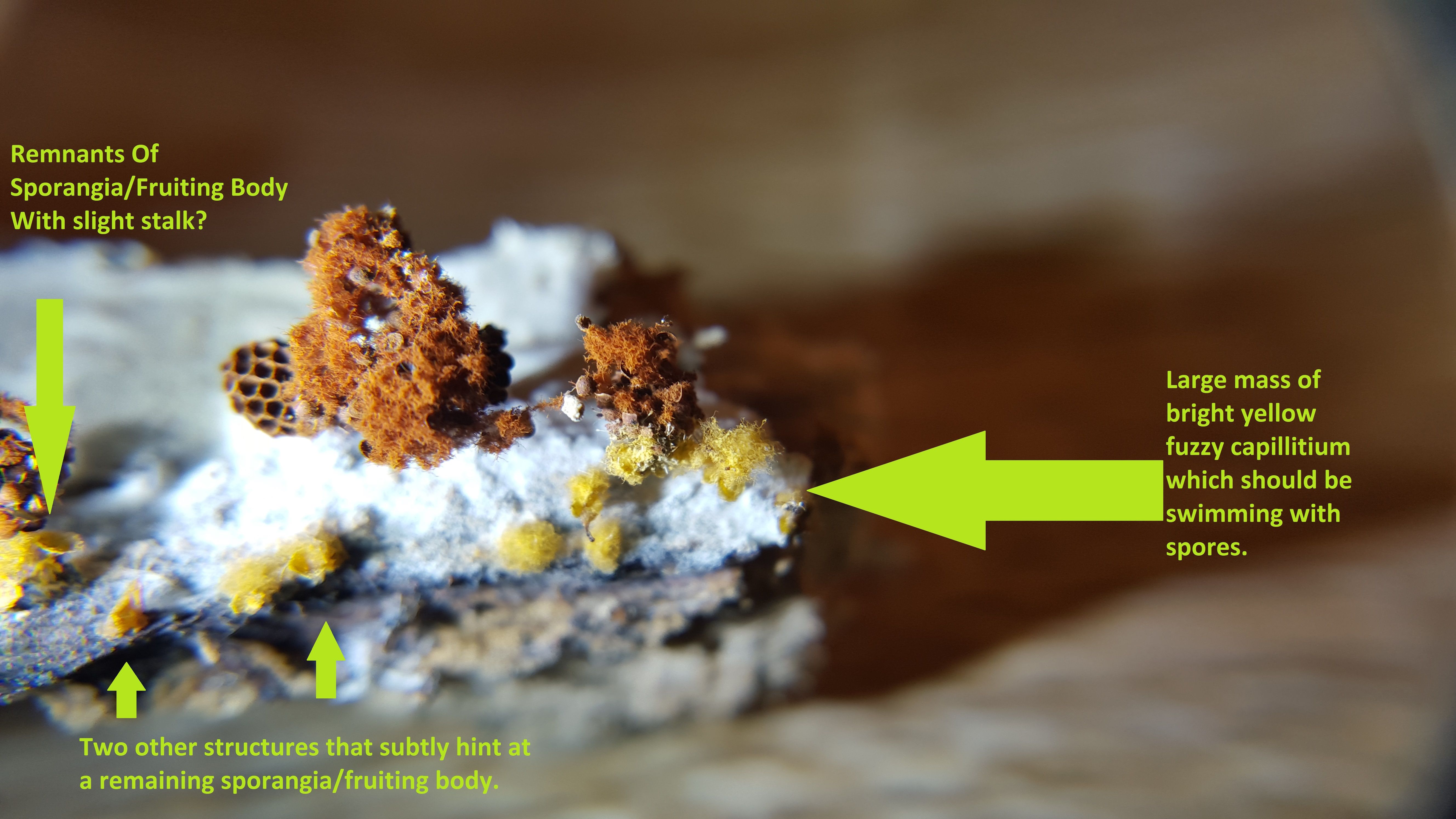
## Compared to the downright gigantic structures of M.vesparium, these yellow guys are tiny.
Tiny and difficult to visualize well enough to get a sense of the structure of their fruiting bodies. Or at least, what remains of the fruiting bodies.
The clearest indication of what the fruiting bodies might once have looked like, in part, is on the far left of the above photo. Keep in mind, this photo was taken with a 40x hand lens, and the fruiting body of this yellow species is so tiny that it is still hardly visible in any detail. **In order to see structures like this, I'm going to need a dissecting microscope - which is currently *third* on my list of future equipment purchases**.
Still, we can come to some conclusions about these yellow guys using what equipment I already have.
#### Let's dive into the microscope and take a look at that yellow fuzz.
********
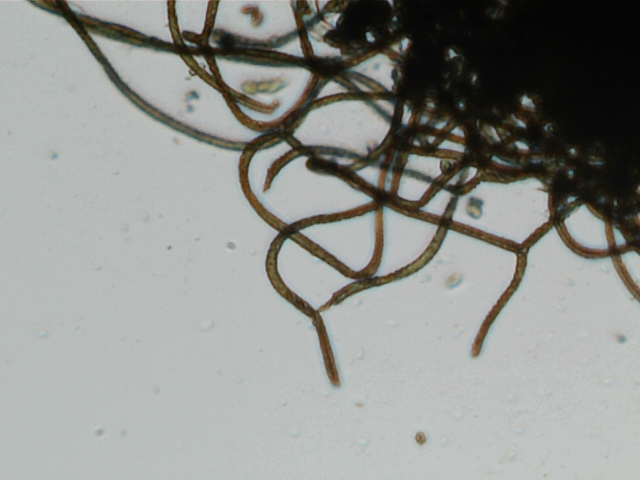
## First thing, we can see the capillitium en masse. This is an important observation to get us into the Trichia/Hemitrichia genuses. Let's zoom in.
***********
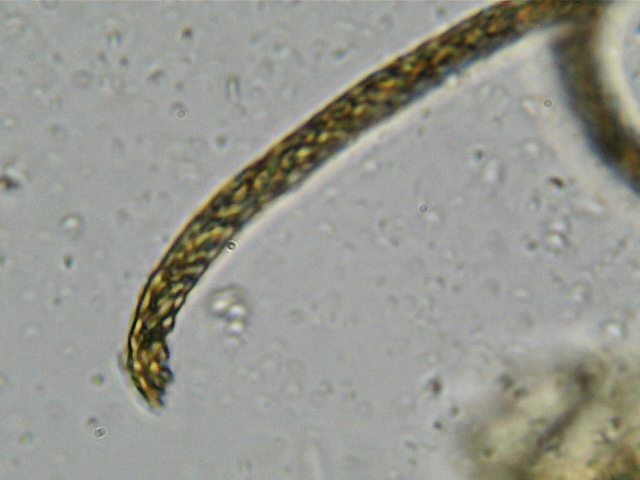
## Here we run into the problem of a a lesser microscope.
This looks to be what is called an "elater" - or a single free strand of capillitium that appears in many species in the Trichia genus. However, in order to identify the specific species, we need to be able to take a closer look at the elaters. One thing we can see here and in the photo right above is that the ends of some of the elators appears to be pointed. We can also see that there is a distinct texture to the elaters.
However, we cannot tell based on these photos precisely how many strands make up the elater's texture - which could be anywhere from 3 to 5 individual spirals. Here we can only see the hint of a woven texture. Plus, I messed up and forgot to measure the elaters when I originally took these photos - and now, because the resolution differs from my viewing software's calibration, I cannot reverse engineer a measurement.
#### Things do not get clearer with the "spores"
******
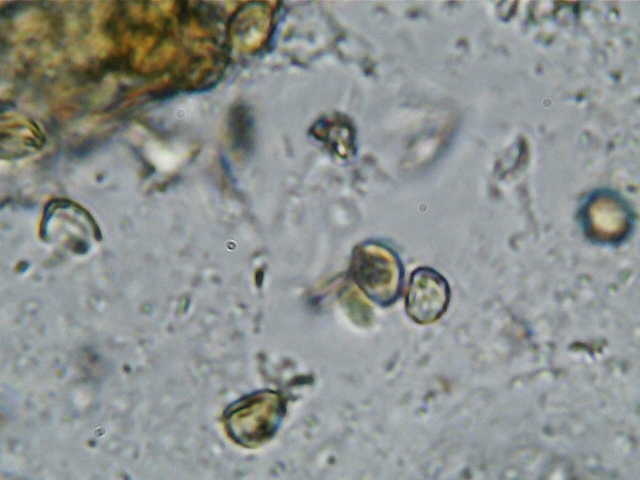
## Is that them there?
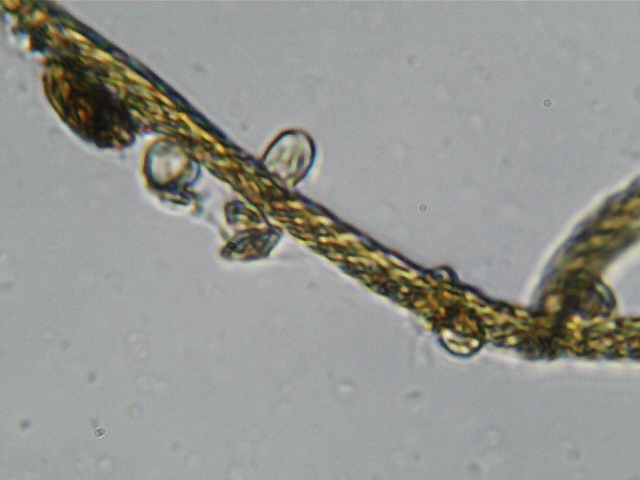
## How about there attached to an elater?
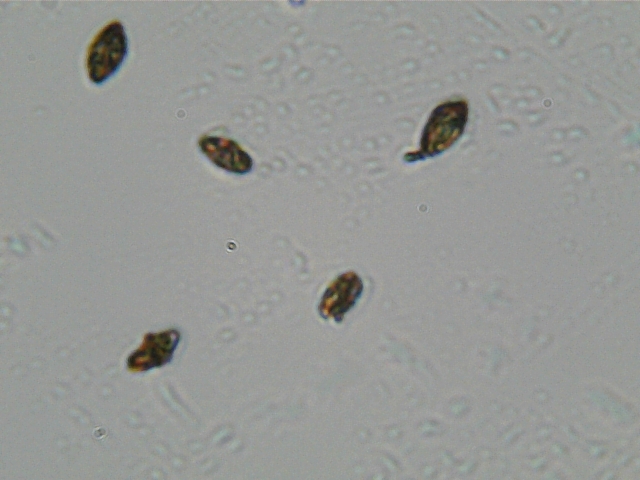
## Or could these be them instead?
My initial foray into slime molds really highlights the need for an oil immersion microscope with a greater degree of magnification. Here, I have a sample that, for one reason or another, has not presented me with an image unequivocal enough for me to discern which objects are even the spores, let alone allowing me to try to make an identifying judgment call.
In this case, either because of the nature of the sample or my preparation, I botched it. I can't make out with any certainty which part of these final images are even relevant. And this a major problem, especially when it comes to myxomycetes.
Even more than many mushroom species, myxomycete identification is often based on microscopic characteristics - especially if you intend on getting down to a species with any degree of accuracy. Some species have such obvious, even explosive macrocharacteristics, like M. vesparium, that microscopy is mostly confirmatory.
#### But in the case of these yellow guys, found at this point in their life cycle, microscopy is not just a confirmatory procedure - it is absolutely central to achieving an ID. Based on the combination of bright yellow macro-characteristics, combined with the presence of elater based, yellow colored, and woven textured capillitium, I think it is likely that these guys were in the genus Trichia or Hemitrichia. But, beyond that, I daren't even fathom a guess.
*********
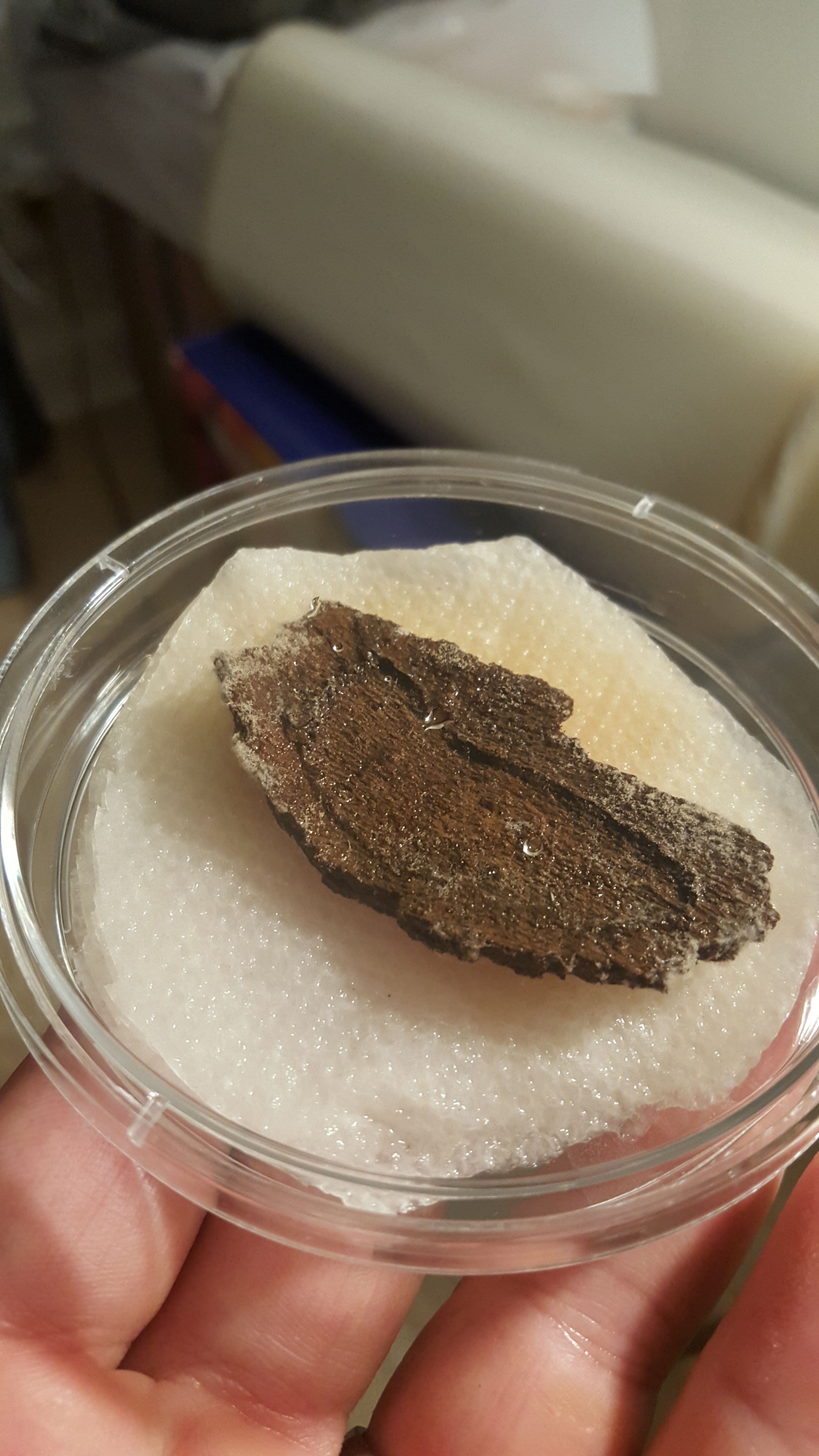
## Although this ID process was not so successful, the quest to further explore slime molds continues with my moist chamber experiment.
After almost two weeks, the initial chamber is still quite moist, but visible growth is still limited to a white fuzz around the edges. However, I had to disturb the sample by moving it from a household tupperware into one of the new empty petri dishes I purchased on amazon. **It is generally frowned upon to open the chamber before sporulation, but my wife wanted a container to put her salad dressing in.**
I am not super optimistic about this first piece of bark at this point. However, far from giving up, I've doubled down.
#### Two days ago I was in Staten Island and harvested several new bark samples
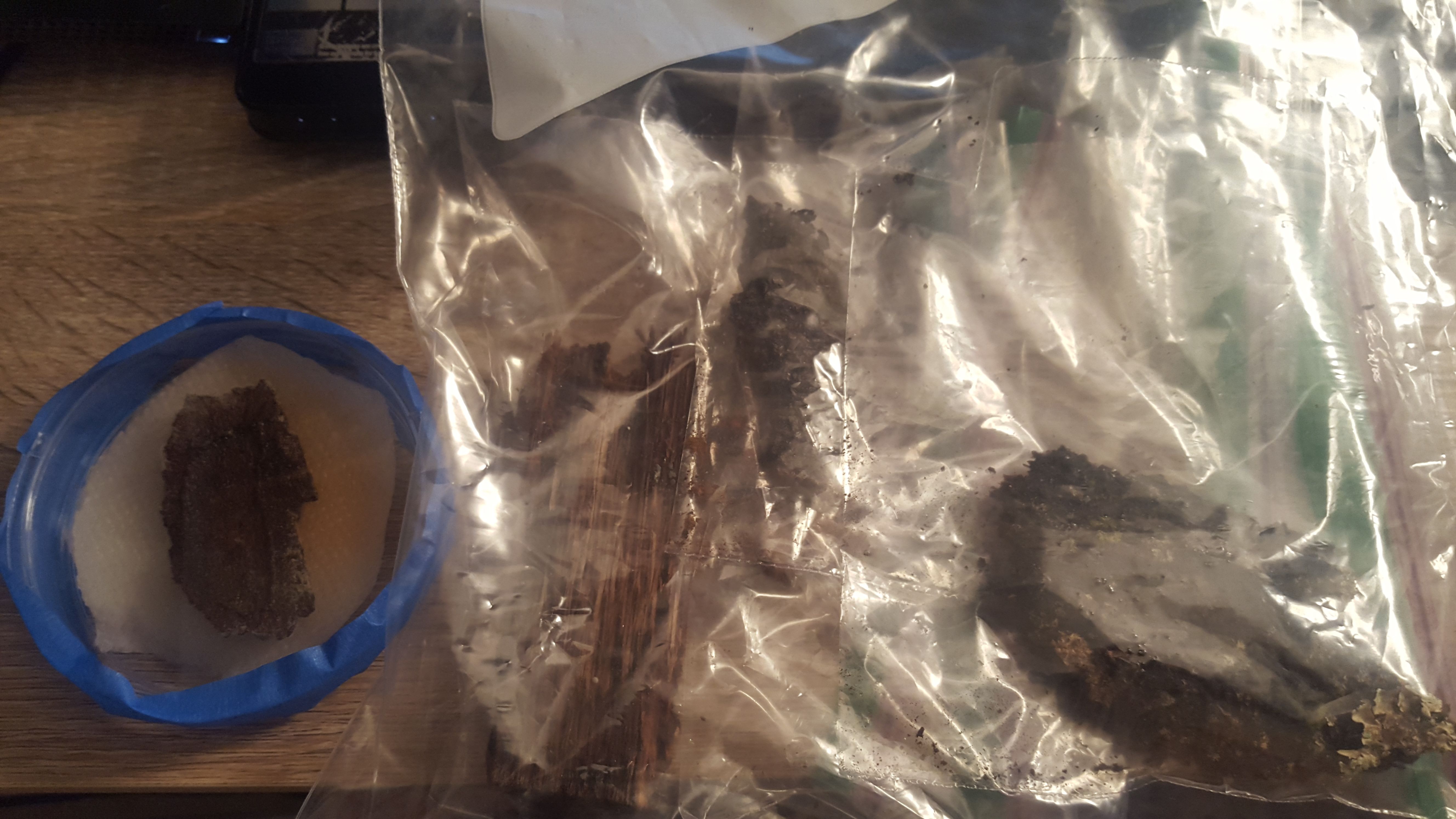
## I will be dividing these up into bite sized pieces and setting up several new moist chambers simultaneously. Between all of them, we should get something over the coming weeks.
## I'll document that moist chamber process, along with a refresher on microscope calibration for my new camera, next week.
*******
## THIS POST IS NOT INTENDED FOR FORAGING PURPOSES AND TO USE IT FOR THOSE PURPOSES WOULD BE DANGEROUS. DO NOT HUNT WILD MUSHROOMS WITHOUT RELYING ON A COMBINATION OF PROFESSIONAL FIELD GUIDES, IN PERSON PROFESSIONAL GUIDANCE, OR IN PERSON GUIDANCE BY SOMEONE TRUSTWORTHY WHO HAS COPIOUS LOCAL, SPECIALIZED MUSHROOM HUNTING EXPERIENCE. FAILURE TO DO SO CAN RESULT IN GRIEVOUS PERSONAL HARM OR DEATH.
***********
************
Photos Are My Own
Microscopic photos were taken using an AMScope M150B entry level microscope. If you use microscopes, I'm quite sure you've never heard of this model - but its cheap and available on Amazon. The camera lens is also AMScope, MD35 - by far their crappiest microscope camera. But, still capable of material, relevant, and in some cases, dispositive, data collection. *Lastly it should be noted that the precise magnifications are not easily deduced using the camera - but based on relative spore sizes compared to known microscopic photos from Kuo and other sources, I estimate 40, 100 and 400x.*
Information Sources
[1][Gary Lincoff, Audobon Society North American Mushroom Field Guide, Hemitrichia clavata, p.850]
[2][Myxomycetes A Handbook of Slime Molds - Steven Stephenson and Henty Stempen, p.156-157]
********
*********
# Support @steemstem and the #steemstem project - curating and supporting quality STEM related content on Steemit
# HAPPY NEW YEAR EVERYONE - THANK YOU FOR AN AMAZING 2017 ON STEEMIT!
******
******
<table>
<tr>
<td>
<div>
<ul class="columns" data-columns="2">
<li><a href="https://steemit.com/science/@dber/the-mushroomer-2-what-is-a-mushroom">What is a mushroom?</a></li>
<li><a href="https://steemit.com/science/@dber/the-mushroomer-3-how-to-identify-a-mushroom">How To ID A Mushroom 101</a></li>
<li><a href="https://steemit.com/science/@dber/the-mushroomer-4-phallus-ravenelii-or-ravenel-s-stinkhorn-2017619t11554505z">Phallus Ravenelii/Ravenel's Stinkhorn</a></li>
<li><a href="https://steemit.com/science/@dber/the-mushroomer-5-lycoperdon-perlatum-the-common-puffball">Lycoperdon perlatum/The Common Puffball</a></li>
<li><a href="https://steemit.com/science/@dber/the-amateur-mycologist-6-lactarius-indigo-the-indigo-milk-cap-2017625t192755427z">Lactarius Indigo/The Indigo Milk Cap</a></li>
<li><a href="https://steemit.com/science/@dber/the-amateur-mycologist-7-amanita-bisporigera-the-destroying-angel">Amanita bisporigera/The Destroying Angel</a></li>
<li><a href="https://steemit.com/science/@dber/the-amateur-mycologist-8-laetiporus-sulphureus-chicken-of-the-woods">Laetiporus sulphureus/Chicken of the Woods</a></li>
<li><a href="https://steemit.com/science/@dber/the-amateur-mycologist-9-boletus-edulis-the-porcini">Boletus edulis/The Porcini</a></li>
<li><a href="https://steemit.com/science/@dber/the-amateur-mycologist-10-coprinus-comatus-the-shaggy-mane">Coprinus comatus/The Shaggy Mane</a></li>
<li><a href="https://steemit.com/science/@dber/the-amateur-mycologist-11-calvatia-gigantea-the-giant-puffball-2017718t112911670z">Calvatia gigantea/The Giant Puffball</a></li>
<li><a href="https://steemit.com/science/@dber/the-amateur-mycologist-12-gyromitra-esculenta-the-false-morel-2017722t21021878z">Gyromitra esculenta/The False Morel</a></li>
<li><a href="https://steemit.com/science/@dber/the-amateur-mycologist-13-super-jumbo-edition-the-elusive-genus-morchella-the-morel-2017726t184758828z">The Genus Morchella/The Morel</a></li>
<li><a href="https://steemit.com/science/@dber/the-amateur-mycologist-15-hericium-erinaceus-the-lion-s-mane-201783t10413229z">Hericium erinaceus/The Lion's Mane</a></li>
<li><a href="https://steemit.com/science/@dber/the-amateur-mycologist-16-stobilomyces-strobilaceus-the-old-man-of-the-woods">Stobilomyces strobilaceus/The Old Man Of The Woods</a></li>
<li><a href="https://steemit.com/steemstem/@dber/the-amateur-mycologist-17-auricularia-auricula-the-jelly-ear-2017817t14117394z">Auricularia auricula/The Jelly Ear Mushroom</a></li>
<li><a href="https://steemit.com/science/@dber/the-amateur-mycologist-18-cortinarius-iodes-the-spotted-cort">Cortinarius iodes/The Spotted Cort</a></li>
<li><a href="https://steemit.com/steemstem/@dber/the-amateur-mycologist-19-phallus-rubicundus-mostly-oc-photos">Phallus rubicundus</a></li>
<li><a href="https://steemit.com/steemstem/@dber/the-amatuer-mycologist-random-find-oc-macro-photography-of-likely-mycenoid-species-perhaps-in-mycena-genus-maybe-even-mycena">Possible "Mycenoid" species/Tiny Mushroom Foray</a></li>
<li><a href="https://steemit.com/steemstem/@dber/the-amateur-mycologist-20-lyophyllum-decastes-oc-photos-and-first-effort-at-microscopy-201799t81342549z">Lyophyllum decastes</a></li>
<li><a href="https://steemit.com/steemstem/@dber/the-amatuer-mycologist-random-finds-probable-young-ganoderma-applanatum-the-artist-s-conk-2017914t114454425z">Random Find Ganoderma applanatum</a></li>
<li><a href="https://steemit.com/steemstem/@dber/the-amateur-mycologist-random-find-beautiful-l-sulphureus-chicken-of-the-wood-2017917t205340956z">Random Find L.sulphureus</a></li>
<li><a href="https://steemit.com/steemstem/@dber/the-amateur-mycologist-21-the-nidulariaceae-or-bird-s-nest-fungi-2017919t132241953z">The Nidulariaceae Family/Bird's Nest Fungi</a></li>
<li><a href="https://steemit.com/steemstem/@dber/the-amateur-mycologist-random-find-an-enlightened-colony-of-lycoperdon-pyriforme-puffballs-2017924t213753157z">Random Lycoperdon Pyriforme</a></li>
<li><a href="https://steemit.com/suesascience/@dber/the-amateur-mycologist-22-agaricus-bisporus-the-white-button-mushroom-the-cremini-mushrom-and-the-portobello-mushroom-suesa-2017925t113328524z">Agaricus bisporus, AKA The Button Mushroom </a></li>
<li><a href="https://steemit.com/steemstem/@dber/the-amatuer-mycologist-random-find-flammulina-velutipes-the-velvet-foot-2017927t15640178z">Random Find, Probable Flammulina velutipes</a></li>
<li><a href="https://steemit.com/steemstem/@dber/the-amateur-mycologist-random-find-likely-agaricus-campestris-the-field-mushroom-2017104t8213931z">Random Find Likely Agaricus campestris</a></li>
<li><a href="https://steemit.com/steemstem/@dber/the-amateur-mycologist-random-find-fomitopsidaceae-family-not-sure-of-species-2017107t10584284z">Random Find, Fomitopsidaceae family, possibly Hapalopilus nidulans</a></li>
<li><a href="https://steemit.com/steemstem/@dber/the-amateur-mycologist-random-find-first-ever-earthstar-geastrum-genus-probably-g-saccatum-2017109t22351363z">Random Find, probably G.saccatum</a></li>
<li><a href="https://steemit.com/steemstem/@dber/the-amateur-mycologist-23-laetiporus-cincinnatus-the-other-chicken-of-the-wood">Laetiporus cincinnatus</a></li>
<li><a href="https://steemit.com/steemstem/@dber/the-amateur-mycologist-tree-health-special-the-infected-giants-of-central-park">Tree Health Special</a></li>
<li><a href="https://steemit.com/steemstem/@dber/the-amatuer-mycologist-24-grifola-frondosa-the-hen-of-the-woods-the-maitake-20171024t11323672z">Grifola frondosa, Hen of the woods.</a></li>
<li><a href="https://steemit.com/steemstem/@dber/the-amateur-mycologist-the-basics-of-mycological-reagents-and-making-an-aqueous-4-5-koh-solution-20171027t13710514z">Reagent Basics and Making KOH Solution</a></li>
<li><a href="https://steemit.com/steemstem/@dber/the-amateur-mycologist-random-find-tulostoma-lloydii-a-puffball-on-a-stick-20171031t111756420z">Random Find - Tulostoma lloydii</a></li>
<li><a href="https://steemit.com/steemstem/@dber/the-amateur-mycologist-26-pycnoporus-cinnabarinus-a-bright-orange-red-mushroom-with-practical-industrial-applications-2017113t121429598z"> Pycnoporus cinnabarinus</a></li>
<li><a href="https://steemit.com/steemstem/@dber/the-amateur-mycologist-random-find-probably-trametes-villosa-spoiler-another-big-microscope-advancement-coming">Random Find - Probably Cerrena unicolor </a></li>
<li><a href="https://steemit.com/steemstem/@dber/the-amateur-mycologist-random-find-beautiful-coprinoid-species-likely-coprinellus-disseminatus-20171110t12172296z">Random Find - Probably Coprinellus disseminatus </a></li>
<li><a href="https://steemit.com/steemstem/@dber/the-amateur-mycologist-26-coprinellus-micaceus-coprinellus-sect-micacei-the-mica-caps-20171114t11587787z">Coprinellus micaceus/Coprinellus Sect Micacei </a></li>
<li><a href="https://steemit.com/steemstem/@dber/the-amateur-mycologist-why-fungi-matter-part-1-saprobic-mushrooms-eaters-of-the-dead-20171117t113843753z">The Importance of Saprobic Fungi </a></li>
<li><a href="https://steemit.com/steemstem/@dber/the-amateur-mycologist-microscope-cleaning-and-calibration-an-exciting-new-advance-in-my-mycological-exploration-ba885ee12c1af"> Cleaning And Calibrating A Microscope </a></li>
<li><a href="https://steemit.com/steemstem/@dber/the-amatuer-mycologist-27-pluteus-cervinus-the-deer-mushroom-dc488fcc47e68"> Pluteus cervinus, "The Deer Mushroom." </a></li>
<li><a href="https://steemit.com/steemstem/@dber/the-amateur-mycologist-28-hypholoma-sublateritium-the-brick-caps-35d2484f199ac"> Hypholoma sublateritium - "Brick Caps" </a></li>
<li><a href="https://steemit.com/steemstem/@dber/the-amateur-mycologist-lycogala-epidendrum-my-first-slime-mold"> Lycogala epidendrum - Wolf's Slime or Toothpaste Mold </a></li>
<li><a href="https://steemit.com/steemstem/@dber/the-amateur-mycologist-30-cordyceps-capitata-a-detailed-analysis-of-the-strangest-mushroom-i-ve-yet-found"> Cordyceps capitata </a></li>
<li><a href="https://steemit.com/steemstem/@dber/the-amateur-mycologist-random-find-probable-crepidotus-genus-a-gorgeous-species-with-spores-that-defy-macro-microscopic"> Probable Crepidotus Mushroom </a></li>
<li><a href="https://steemit.com/steemstem/@dber/the-amateur-mycologist-myxomycetes-slime-molds-and-my-ongoing-moist-chamber-experiment-or-how-to-grow-your-own-slime-mold-in-a"> Myxomycetes Overview</a></li>
<li><a href="https://steemit.com/steemstem/@dber/the-amateur-mycologist-probably-metatrichia-vesparium-behold-some-serious-slime-mold-wierdness"> Metatrichia vesparium</a></li>
</ul>
</div>
</td>
</tr>
</table>👍 dber, ghanexs, ocrdu, ruth-girl, alexpmorris, freeinthought, lordkingpotato, sustainablyyours, anarchyhasnogods, bloom, mangos, frugallady, lemouth, fungiflora, bikkichhantyal, tutufaith, derz, justtryme90, steemstem, kyriacos, the-devil, foundation, lamouthe, himal, lafona-miner, nitesh9, rachelsmantra, dna-replication, kerriknox, gra, rjbauer85, curie, rockeynayak, liberosist, meerkat, dante31, hendrikdegrote, papadimos, anwenbaumeister, kryzsec, dejan.vuckovic, sci-guy, awesomianist, kingyus, ewuoso, webresultat, plojslydia, blogtrovert, kerry234, jasimg, xanderslee, amavi, gentleshaid, cryptokrieg, mystifact, xpressng, zoneboy, khalilmuza, kushed, mobbs, nataliejohnson, kenadis, gotgame, sammarkjames, thelovejunkie, cryptoninja, pharesim, cancep, timothyb, ongoingwow, alexander.alexis, ovij, kedi, geekpowered, jamhuery, kharrazi, azirgraff, somethingburger, aboutcoolscience, timsaid, xeroc, cotidiana, cindyx, shahzadnisar, gamesjoyce, toxichan, steemedia, bp423, erangvee, socialspace, cebymaster, pacokam8, howtostartablog, sieses, diggerdugg, playitforward, mrblinddraw, funnyman, trucklife-family, resteem.bot, rana420, gretum, steem-id, blakemiles84, gomeravibz, phenom, dan-bn, jaeydallah, techmojo, taylor.swift, ted7, rayken04, subversion, robinhaney, trumpman, mcw, azen, danieler, jakhay, carloserp-2000, motordrive, steem100, ccworld, msp-lovebot, rafalski, siniy, teamsteem, seer, outwalking,